Is Going
To The
Movies Still Worth It!
When it comes to outside entertainment, the US public continues to favor going out to catch a movie. But as movie ticket prices continue to increase and the cost of home entertainment systems comes down, there is now more reason than ever to invest in creating the movie experience at home instead.
We have trawled through the latest charts and tables to draw up a picture of the current viewing, screening and cost trends in the movie industry. We wanted to find out the answers to some big questions:
Theater
admissions steady
as screen counts continue to rise
Admissions data provide a high level view on the popularity of movies in North America. Screen count data does the same for industry activity. We looked at the main trends and some of the finer details to answer the following key questions:
The film industry continues to be big business in the United States, generating 6.4% of the country’s economy. In fact, the movies attract more viewers than all of the major theme parks and sports events combined (yes, that includes football, basketball, baseball and hockey).


In terms of admissions, the numbers haven’t changed much in the last 15 years after reaching a peak of over 1.5 billion in both 2002 and 2003. 2018 saw 1.30 billion movie admissions, an increase from 2017 figures (1.24 billion) but fewer than admissions in 2015 and 2016 (both 1.32 billion).
This works out at 3.6 movies per year for the average American but raw admission figures like this don’t take into account any variation in movie consumption between different groups. For example, looking deeper into the figures reveals a warping effect from hard core movie buffs. Granular data, taken from an MPAA survey in 2018, found that frequent moviegoers (those that attend at least a movie every month), were responsible for 12% of all admissions and purchased 49% of all tickets sold.
2018 saw 1.30 billion movie admissions, an increase from 2017 figures
The number of movies consumed per year also varies by age and ethnicity.
The age group most likely to be seen in a movie theater are 25-39 year olds (25% of frequent moviegoers) but 12 to 24 year olds watch more movies per year. The combined cohorts of 12-17 and 18-24 year olds watch an average of 5.1 movies per year.
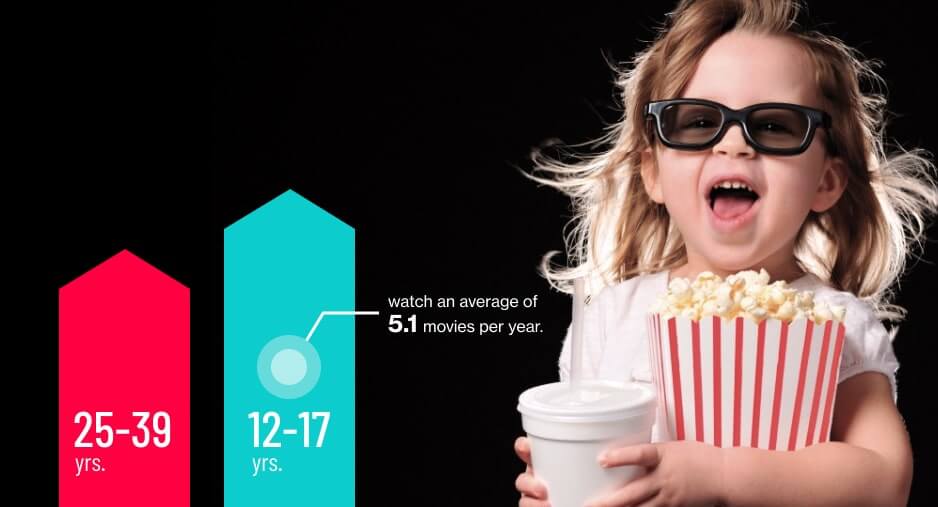
Movies watched by Age Groups

Total Films Released in USA and Canada
758 films were released in the US and Canada in 2018. Of these, 631 were produced by non-MPAA member independents.

In addition to increasing the number and variety of titles available, the movie industry has used technology to improve the movie-going experience. One of the fastest growing examples, revealed by IHS Market, has been IMAX and other Premium Large Format (PLF) screens. Although only a small proportion of overall admissions are to PLF movies, 2018 saw a jump of 7% to 3,372 screens. With Sony Digital Camera now entering the PLF space with its dual 4K laser technology, the 64% market share enjoyed by IMAX could be under threat.
39% of the movies screened were in 3D format, a total of 16,933.

3D is another technology on the rise. In 2018, 39% of movies screened were in 3D format, a total of 16,933. This was slightly down from 16,978 a year earlier.
Box office takings
strong but home
entertainment spending soars
Looking at viewing figures and industry activity is one thing but if you really want to gauge the health of an industry, you need to follow the money.
We looked at both recent box office figures and the revenue from on demand subscription services like Netflix, Prime Video and Hulu to get an idea of where Americans are spending their movie entertainment dollars. Questions we asked included:
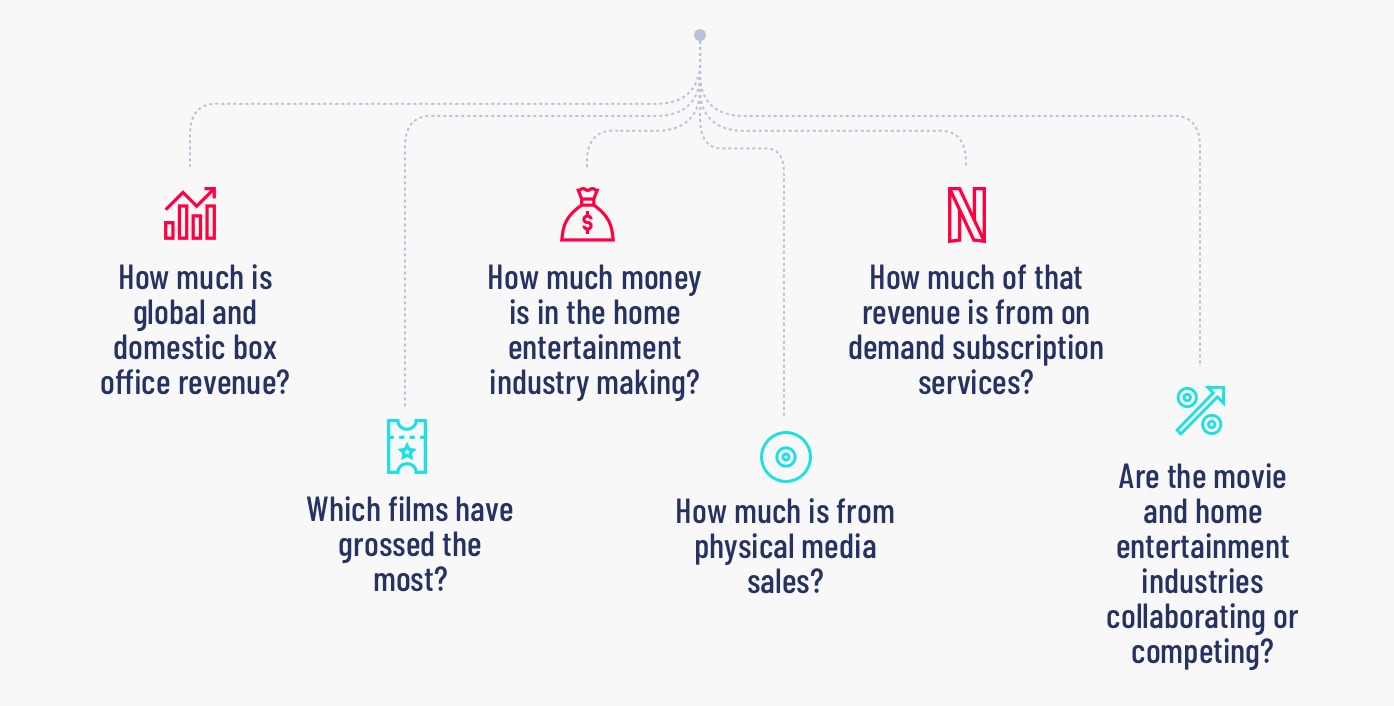
As things stand, the global and domestic movie industries both seem in good shape. Global box office takings in 2018 were a record-busting $41.1 billion. American figures also hit a record high for the third time in four years, taking $11.9 billion. The China box office once again performed well by contributing $9 billion to the figures, an increase of 14%.
The biggest Hollywood films continue to draw the crowds and generate hundreds of millions of dollars over a weekend. The biggest grossing US movie of 2018 was Disney’s Black Panther which brought in $700.1 million. Avengers: Endgame took $357 million in 2019 but is expected to be knocked off its perch by the final film of the Star Wars series, The Rise of Skywalker. This movie is expected to gross at least $550 million when it is released in December 2019.



Online Streaming & Home Entertainment Sales 2018
But what of the home entertainment industry? It seems that this is booming as well with $55.7 billion spent on home entertainment in 2018, an increase of 16%. America’s share of that market was $23.3 billion, with digital media up 24% and physical media, such as DVDs, continuing to fall with a 15% drop in revenue, mirroring the global trend.
Looking back further, digital home entertainment media has exploded in the past 4 years, increasing by a whopping 171%!
The fact that Netflix joined the MPAA in 2019 (that’s the body representing the big six Hollywood film studios) and that the MPAA now includes home entertainment in its annual film industry health report itself speaks volumes about the growing symbiotic relationship between Hollywood and the digital distributors. With the DVD market in freefall, Hollywood needs to breathe new life into its distribution channels.

The president of the National Association of Theatre Owners (NATO) is also backing digital subscription services. He explains that those film buffs with the most home technology are also the most frequent moviegoers. If the digital streaming service providers can increase their revenues, this should lead to bigger and better movies.
There is currently a lot of debate (and controversy) about whether on demand streaming services should fall into line with traditional movies and release their exclusives to movie theaters before streaming them. For one thing, this would attract better actors as they would be more likely to earn academy awards.
Netflix in particular has so far resisted all but token theater runs but this blending of movies and home entertainment is likely to develop further over the coming years.
Tickets and popcorn:
prices up
again in 2019
So if admissions figures are staying more or less static yet box office takings are performing as well as ever, what can we conclude?
Yes, ticket prices are on the rise again!
The average price for a movie ticket up to Q3 in 2019 was $9.08 compared to $9.11 in 2017, a slight decrease of 0.3%. To put this in perspective, $9.11 would have got you 181 tickets at 1907 prices (5 cents per ticket) or 25 tickets at 1948 prices (36 cents per ticket). Even accounting for inflation, you would have been able to buy 3 tickets at today’s prices.

The following table charts the rise…and (mostly) rise of movie ticket prices in the years since (plus the top grossing movies you could have watched at the time):

Movie Popcorn & Snacks Price 2018
Then there is the additional costs of snacks. The average price of a bag of popcorn is now $7.99. You could have enjoyed 12 bags for that price back in 1962 when the cost was just 62 cents.

NATO are keen to point out that theaters have improved significantly over the years with high quality projection, better seating, user-friendly sight lines and expanded food and beverage services. Profits have also funded the development of large format screens, 3D projection and other technologies.
How much does it cost to sit back at home and enjoy the latest on demand movies? Netflix and Prime Video both offer their basic subscription packages for $8.99 per month (Netflix hiked the prices of all their plans at the start of 2019) while Hulu comes in cheaper at $5.99 per month.
As on demand
services skyrocket,
is staying in the new
going out?
Netflix, Prime, Hulu Subscriptions 2018
The affordability of on demand movie streaming platforms like Netflix, Hulu and Prime Video has clearly had a dramatic effect on the way people consume entertainment at home as the revenue figures we mentioned earlier prove.

In terms of subscriber volume, on demand is now the most popular home digital entertainment type with 613.3 million subscribers. This is a meteoric rise when you consider that there were only 100 million subscribers in 2013. From there, on demand soared past satellite TV subscriptions in 2015 and cable subscriptions during 2017.
As Cable continues to suffer from the ‘cord-cutting’ phenomena, where people cancel their subscriptions in favor of streaming services, new players are entering the online streaming space.
In November 2019, Apple launched its Apple TV + service on its website and TV app. They was shortly followed by Disney whose Disney + streaming service debuted in the US, Canada and Netherlands the same month. This will impact Netflix which has been the ‘go to’ destination for the online streaming of Disney blockbusters due to a deal between the two companies. That deal will not be renewed but, due to the complexities of licensing contracts, Netflix will still show some Disney titles.
Apple TV+ and Disney+

With the costs of home theater systems coming down, there has been no better time to consider bringing your movie entertainment in-house and saving on those pricey theater tickets.
Here is a basic breakdown of what an average home theater set up would cost you (there is a wide variation in price, so this is a basic guide only). This also assumes you will be able to set the equipment up yourself and are not planning a custom installation or room refurbishment.
THE COSTS OF A HOME THEATER SYSTEM
If you decide to opt for a projector and screen instead of a TV your price will increase but you should still be able to get everything for within $2,000
Home theater system (receiver and speaker system)
$320
42 inch flat screen LCD Smart TV
$470
Years' subscription to Prime Video or Netflix
$110
Bonded leather power recliner
$840
Remote control
$10
Total Cost - $1,750
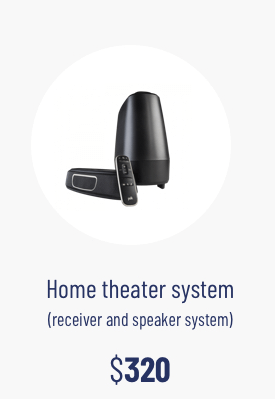

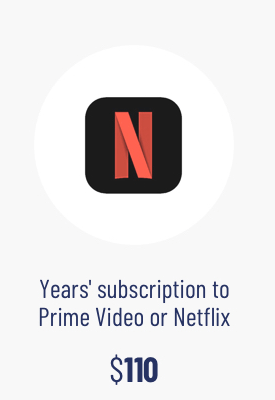

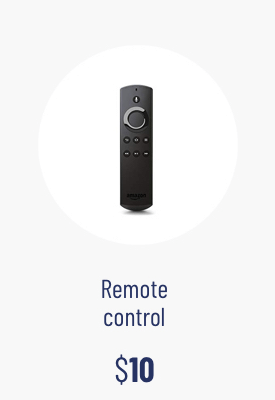

How does this compare with going to the movies? Let’s say you are one of the 800,000 subscribers to AMC Theatres’ Stubs A-List program. This will get you three movies a week at a price of $19.95 per month.
Over 2 years, you would be paying over $2,150!
As you can see, setting up your own home theater system does make financial sense, especially when you consider the high resolution displays, high quality sound and comfortable home theater seating now available at affordable prices.
